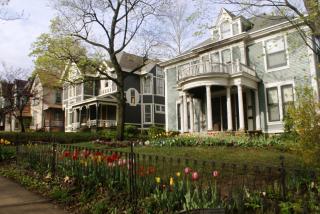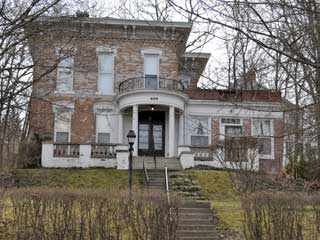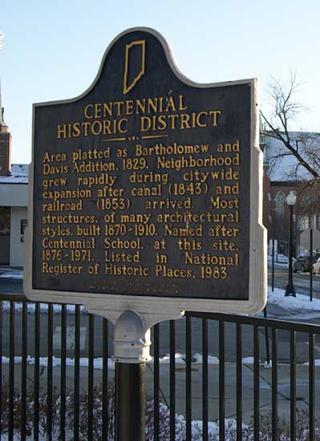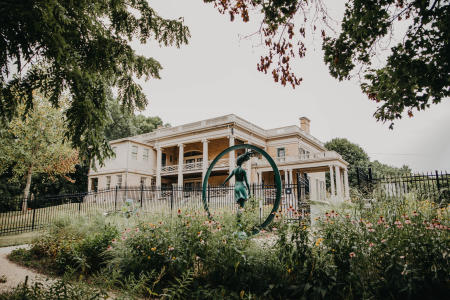Historic Ninth Street Hill

One of Lafayette’s oldest downtown areas. William Digby (founder of Lafayette) platted the town as far as what is now 6th Street in 1825. By 1841, the street was called Clark St., the area later became known as “Prospect Hill” and was called that as late as 1878. Officially, according to city records, in July of 1860, Clark Street became 9th Street. The homes on 9th Street Hill were primarily built from the 1840s to the 1950s. They are known for offering a vignette of the history of life in Lafayette.
Highland Park Land Company

Was organized in 1891, the 160 acre park-like area had previously been a pasture. It was platted into 136 lots with broad streets and sweeping curves. The group put out a brochure showing house examples and extolling the advantages of the area. It claimed that it was near the heart of the city, yet situated on the highlands, away from noise and dirt. The neighborhood features 240 homes that were primarily built from 1892 until 1945. Many examples of Craftsman, Queen Anne, Classical Revival, Colonial Revival, Tudor Revival, and Prairie Style are preserved in this area.
Historic Perrin Neighborhood

Lawrence B. Stockton built his home on Main Street and this area became known as Stockton’s Woods. It was a favorite with children who came here to find wildflowers and pick up nuts. The district was unusual because it followed the natural topography of the land. Limestone curbs, terraced lawns, curving streets and cobblestone alleys helped create a gracious atmosphere. The majority of the homes in the area were built between 1875-1890.
The Centennial Neighborhood

Includes sections of Lafayette platted just four years after the City of Lafayette. Merchants, who had been living above their shops, built here because it was so convenient. The arrival of the Wabash & Erie Canal in the 1840s and the railroads in the 1850s also contributed to the growth. The buildings in the neighborhood represent a variety of architectural styles. These include Federal, Queen Anne, Greek Revival, Italianate, Second Empire, Gothic Revival, Neo-Classical, and Craftsman. The majority of these homes were built dating back from the 1840s to the 1920s. The neighborhood was named to honor the Centennial School that stood at the corner of Sixth and Brown Streets. The school was built in 1876 during the United States Centennial and torn down in 1971.
St. Mary’s Historic Neighborhood

Encompasses Main, Columbia, and South Streets from the bottom of the hills at 10th Street up to the Five Points intersection. The area was named in honor of St. Mary’s Cathedral that has greatly influenced the development of the neighborhood. The church was started in 1860 and completed after the Civil War. Many of the early residents were members and moved here because they wanted to be near their church. Buildings represent a variety of architectural styles and date from the 1850s to modern homes and apartments.
History of various historic houses
Moses Fowler House
This English Gothic home was built in 1851-52 by Moses Fowler, who was a cattle baron, banker, merchant, and a railroad builder. Mr. Fowler came to Lafayette in 1839 with John Purdue to open a merchandising business. The home is built with bricks fired not far from the site, and used local woods for both the exterior and interior work. As far as it is known, there were no plans for the original part of the house, instead A.J. Downing’s book, Architecture of Country Homes, was used as a guide. The home was remodeled by Moses’ grandson in 1916. It was purchased from him in the early 1940s by the Tippecanoe County Historical Assoc. Today Fowler House is a premier event venue as well as a restaurant offering lunch as well as specialty brunch events.
Judge Cyrus Ball House
Cyrus Ball was one of the area’s earliest settlers, coming before 1827. He was a successful merchant, and later was elected Justice of the Peace and then appointed collector of tolls for the Canal. In the 1840s he was cashier of the State Bank of Indiana and in 1857 was elected Associate Judge and from then on was known as “Judge” Cyrus Ball. His wife was a published author. She wrote poetry and also anti-slavery stories for eastern magazines. It is reported that an earlier home of theirs was a stop on the Underground Railroad. This home was started in 1864, on what was called “the pasture” since the land was used for grazing livestock.
Frank Lloyd Wright’s SAMARA

The John E. Christian House (1954), located in West Lafayette, Indiana, represents a pristine example of Frank Lloyd Wright's Usonian architecture. Still occupied by the original client and owner, Dr. John Christian, SAMARA is strictly maintained to the exacting standards set by Mr. Wright. SAMARA contains refinements of over forty innovations by this world famous architect, yet is unique in that it was specifically designed for Dr. Christian and his wife, Catherine, and their daughter, Linda.
William S. Potter/Haan Mansion

Mr. Potter’s father, William A. Potter, came to Lafayette in 1843 when he was 24 years old. He was very successful in the merchandising business and also an active partner in several mills. William S. perhaps even surpassed his father’s expectations. He was a lawyer and developed large and important reality interests. He was vice-president and director of Northern Indiana Land Co. which owned 25,000 acres between Lafayette and Chicago for development. He also had large real estate holding in Chicago and Texas. He was also associated with the National Fowler Bank, Merchants Electric Light Assoc. and the Lincoln Life Insurance Co. He and his wife, Fanny, brought this beautiful house on State St. to this community. It originally was built by the State of Connecticut to house their exhibit at the Worlds’ Fair in St. Louis in 1904. After the Fair closed, they had it dismantled, packed and shipped to Lafayette where he had prepared a 4 acre site. It was purchased by founders Bob and Ellie Haan in 1984 who had an extensive collection of art by Indiana artists except for the paintings of American Indians, all of which are by Martin Grelle. Today the mansion is the Haan Museum of Indiana Art. It showcases an extraordinary collection of Indiana art, including paintings, ceramics, bronzes, and stone sculptures. There is also a wide array of massive antique American furniture.
Tour de Lafayette- West Lafayette
Enjoy twelve webcasts featuring nine historic neighborhoods located throughout Lafayette—West Lafayette, Indiana at TourdeLafayette.com. There are nine Lafayette webcasts focused on eight historic neighborhoods. Each episode runs 5-7 minutes long and focuses on 4-5 different sites within the neighborhood (historic homes, museums, parks, etc.) There are four West Lafayette webcasts; Hills & Dales Neighborhood, New Chauncey Neighborhood, Mid Century Homes and The Village. This website is meant to broadcast to the world the unique heritage of each neighborhood in Lafayette—West Lafayette as a whole.
